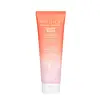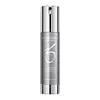What's inside
What's inside
 Key Ingredients
Key Ingredients

 Benefits
Benefits

 Concerns
Concerns

 Ingredients Side-by-side
Ingredients Side-by-side

Water
Skin ConditioningAloe Barbadensis Leaf Juice
Skin ConditioningCaprylic/Capric Triglyceride
MaskingGlycerin
HumectantGlyceryl Stearate
EmollientCetyl Alcohol
EmollientStearyl Alcohol
EmollientSodium Cocoyl Isethionate
CleansingHelianthus Annuus Seed Oil
EmollientHydroxypropyl Starch Phosphate
Hydrolyzed Jojoba Esters
Skin ConditioningPerlite
AbsorbentOryza Sativa Starch
AbsorbentParfum
MaskingEthylhexylglycerin
Skin ConditioningTerminalia Ferdinandiana Fruit Extract
AntioxidantAscorbic Acid
AntioxidantLactic Acid
BufferingGlycolic Acid
BufferingPapain
Skin ConditioningBromelain
Skin ConditioningMaltodextrin
AbsorbentTocopherol
AntioxidantMalic Acid
BufferingVanilla Planifolia Fruit Extract
Skin ConditioningPhenoxyethanol
PreservativeIron Oxides
Galactoarabinan
Sodium Riboflavin Phosphate
Skin ConditioningWater, Aloe Barbadensis Leaf Juice, Caprylic/Capric Triglyceride, Glycerin, Glyceryl Stearate, Cetyl Alcohol, Stearyl Alcohol, Sodium Cocoyl Isethionate, Helianthus Annuus Seed Oil, Hydroxypropyl Starch Phosphate, Hydrolyzed Jojoba Esters, Perlite, Oryza Sativa Starch, Parfum, Ethylhexylglycerin, Terminalia Ferdinandiana Fruit Extract, Ascorbic Acid, Lactic Acid, Glycolic Acid, Papain, Bromelain, Maltodextrin, Tocopherol, Malic Acid, Vanilla Planifolia Fruit Extract, Phenoxyethanol, Iron Oxides, Galactoarabinan, Sodium Riboflavin Phosphate
Water
Skin ConditioningGlycolic Acid
BufferingCaprylic/Capric Triglyceride
MaskingLactic Acid
BufferingGlycerin
HumectantPropylene Glycol
HumectantSodium Hydroxide
BufferingPEG-100 Stearate
Squalane
EmollientGlyceryl Stearate
EmollientSteapyrium Chloride
AntimicrobialCarthamus Tinctorius Seed Oil
MaskingChamomilla Recutita Flower Extract
MaskingCamellia Sinensis Leaf Extract
AntimicrobialAloe Barbadensis Leaf Juice
Skin ConditioningTocopheryl Acetate
AntioxidantRetinyl Palmitate
Skin ConditioningCetyl Alcohol
EmollientMyristyl Alcohol
EmollientStearyl Alcohol
EmollientDimethicone
EmollientAllantoin
Skin ConditioningDisodium EDTA
Sodium Benzoate
MaskingCitric Acid
BufferingPhenoxyethanol
PreservativeEthylhexylglycerin
Skin ConditioningPotassium Sorbate
PreservativeWater, Glycolic Acid, Caprylic/Capric Triglyceride, Lactic Acid, Glycerin, Propylene Glycol, Sodium Hydroxide, PEG-100 Stearate, Squalane, Glyceryl Stearate, Steapyrium Chloride, Carthamus Tinctorius Seed Oil, Chamomilla Recutita Flower Extract, Camellia Sinensis Leaf Extract, Aloe Barbadensis Leaf Juice, Tocopheryl Acetate, Retinyl Palmitate, Cetyl Alcohol, Myristyl Alcohol, Stearyl Alcohol, Dimethicone, Allantoin, Disodium EDTA, Sodium Benzoate, Citric Acid, Phenoxyethanol, Ethylhexylglycerin, Potassium Sorbate
 Reviews
Reviews

Ingredients Explained
These ingredients are found in both products.
Ingredients higher up in an ingredient list are typically present in a larger amount.
Aloe Barbadensis Leaf Juice comes from leaves of the aloe plant. Aloe Barbadensis Leaf Juice is best known for helping to soothe sunburns. It is also anti-inflammatory, moisturizing, antiseptic, and can help heal wounds.
Aloe is packed with good stuff including Vitamins A, C, and E. These vitamins are antioxidants, which help fight free-radicals and the damage they may cause. Free-radicals are molecules that may damage your skin cells, such as pollution.
Aloe Barbadensis Leaf Juice also contains sugars. These sugars come in the form of monosaccharides and polysaccharides, folic acid, and choline. These sugars are able to help bind moisture to skin.
It also contains minerals such as calcium, 12 anthraquinones, fatty acids, amino acids, and Vitamin B12.
Learn more about Aloe Barbadensis Leaf JuiceThis ingredient is an emollient, solvent, and texture enhancer. It is considered a skin-softener by helping the skin prevent moisture loss.
It helps thicken a product's formula and makes it easier to spread by dissolving clumping compounds.
Caprylic Triglyceride is made by combining glycerin with coconut oil, forming a clear liquid.
While there is an assumption Caprylic Triglyceride can clog pores due to it being derived from coconut oil, there is no research supporting this.
Learn more about Caprylic/Capric TriglycerideCetyl Alcohol is a fatty alcohol. Fatty Alcohols are most often used as an emollient or to thicken a product.
Its main roles are:
Though it has "alcohol" in the name, it is not related to denatured alcohol or ethyl alcohol.
The FDA allows products labeled "alcohol-free" to have fatty alcohols.
Learn more about Cetyl AlcoholEthylhexylglycerin (we can't pronounce this either) is commonly used as a preservative and skin softener. It is derived from glyceryl.
You might see Ethylhexylglycerin often paired with other preservatives such as phenoxyethanol. Ethylhexylglycerin has been found to increase the effectiveness of these other preservatives.
Glycerin is already naturally found in your skin. It helps moisturize and protect your skin.
A study from 2016 found glycerin to be more effective as a humectant than AHAs and hyaluronic acid.
As a humectant, it helps the skin stay hydrated by pulling moisture to your skin. The low molecular weight of glycerin allows it to pull moisture into the deeper layers of your skin.
Hydrated skin improves your skin barrier; Your skin barrier helps protect against irritants and bacteria.
Glycerin has also been found to have antimicrobial and antiviral properties. Due to these properties, glycerin is often used in wound and burn treatments.
In cosmetics, glycerin is usually derived from plants such as soybean or palm. However, it can also be sourced from animals, such as tallow or animal fat.
This ingredient is organic, colorless, odorless, and non-toxic.
Glycerin is the name for this ingredient in American English. British English uses Glycerol/Glycerine.
Learn more about GlycerinGlyceryl Stearate is a mix of glycerin and stearic acid.
It is used to stabilize the mixing of water and oil ingredients. By preventing these ingredients from separating, it can help elongate shelf life. It can also help thicken the product's texture.
As an emollient, it helps soften skin and supports barrier-replenishing ingredients.
In cosmetics, Glyceryl Stearate is often made from vegetable oils or synthetically produced.
This ingredient may not be fungal-acne safe
Fun fact: The human body also creates Glyceryl Stearate naturally.
Learn more about Glyceryl StearateGlycolic Acid is arguably the most famous alpha hydroxy acid (AHA) with tons of research backing its benefits.
It is found naturally in sugar cane but the form used in skincare is usually synthetic for purity and stability.
Glycolic acid removes the top layer of dead skin cells to allow newer and fresher ones to emerge.
AHAs work by breaking down the structural “glue” that holds old skin cells in place. When that buildup is gone, your skin can renew itself more efficiently.
Research also shows glycolic acid stimulates collagen production, helping to firm and thicken the skin over time. This is one of its biggest advantages over other AHAs.
Overall, glycolic acid helps with:
Fun fact: Glycolic acid boosts skin hydration by helping it produce molecules that increase hyaluronic acid naturally.
To work best, glycolic acid products should have a pH between 3-4 (that’s where exfoliation is most effective but still gentle on skin).
The pH and concentration of a product are key to its effectiveness:
It is normal to feel a slight stinging sensation when using glycolic acid. This usually fades as your skin adjusts.
Because glycolic acid has the smallest molecular size in the AHA family, it can penetrate deeper, which enhances its effectiveness but also makes it more likely to irritate sensitive skin.
If your skin is very sensitive or prone to rosacea, glycolic acid may be too strong; in that case, try milder options like lactic acid or a PHA instead.
Recent studies suggest glycolic acid might even help protect against UV damage. But don’t skip sunscreen! Freshly exfoliated skin is more sensitive to the sun.
Glycolic acid is a skincare superstar. It smooths, brightens, hydrates, and firms the skin. Unless you’re highly sensitive, it’s well worth adding to your routine.
Read more about some other popular AHA's here:
Learn more about Glycolic AcidLactic Acid is another well-loved alpha hydroxy acid (AHA). It is gentler than glycolic acid but still highly effective.
Its main role is to exfoliate the surface of the skin by loosening the “glue” that holds dead skin cells together. Shedding those old cells leads to smoother, softer, and more even-toned skin.
Because lactic acid molecules are larger than glycolic acid, they don’t penetrate as deeply. This means they’re less likely to sting or irritate, making it a great choice for beginners or those with sensitive skin.
Like glycolic acid, it can:
Lactic acid also acts as a humectant (like hyaluronic acid). It can draw water into the skin to improve hydration and also plays a role in the skin's natural moisturizing factor (NMF) in the form of sodium lactate.
Studies show it can boost ceramide production to strengthen the skin barrier and even help balance the skin’s microbiome.
To get results, choose products with a pH between 3-4.
Lower strengths (5-12%) focus on surface exfoliation; higher strengths (12% and up) can reach deeper in the dermis (deeper, supportive layer) to improve skin texture and firmness over time.
Though it was originally derived from milk, most modern lactic acid used in skincare is vegan. It is made through non-dairy fermentation to create a bio-identical and stable form suitable for all formulations.
When lactic acid shows up near the end of an ingredient list, it usually means the brand added just a tiny amount to adjust the product’s pH.
Legend has it that Cleopatra used to bathe in sour milk to help reduce wrinkles.
Lactic acid is truly a gentle multitasker: it exfoliates, hydrates, strengthens, and brightens. It's a great ingredient for giving your skin a smooth, glowing, and healthy look without the harshness of stronger acids.
Read more about some other popular AHA's here:
Learn more about Lactic AcidPhenoxyethanol is a preservative that has germicide, antimicrobial, and aromatic properties. Studies show that phenoxyethanol can prevent microbial growth. By itself, it has a scent that is similar to that of a rose.
It's often used in formulations along with Caprylyl Glycol to preserve the shelf life of products.
Stearyl Alcohol is a type of fatty alcohol from stearic acid. It is a white, waxy compound used to emulsify ingredients.
Fatty Alcohols are most often used as an emollient or to thicken a product. Emollients help soothe and hydrate the skin by trapping moisture.
They are usually derived from natural fats and oils and therefore do not have the same drying or irritating effect as solvent alcohols. FDA allows products labeled "alcohol-free" to have fatty alcohols.
Learn more about Stearyl AlcoholWater. It's the most common cosmetic ingredient of all. You'll usually see it at the top of ingredient lists, meaning that it makes up the largest part of the product.
So why is it so popular? Water most often acts as a solvent - this means that it helps dissolve other ingredients into the formulation.
You'll also recognize water as that liquid we all need to stay alive. If you see this, drink a glass of water. Stay hydrated!
Learn more about Water